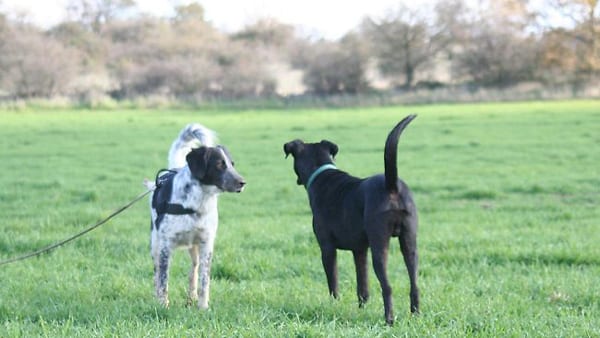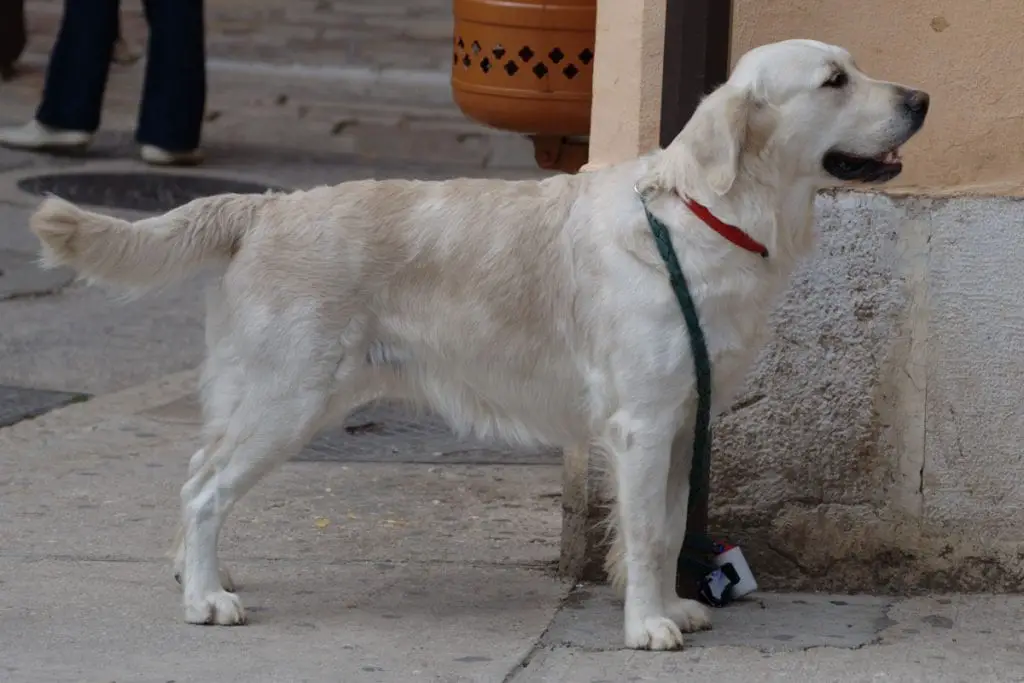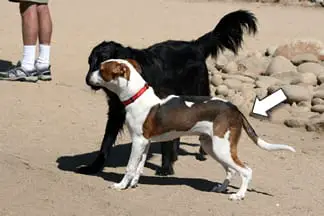We all assume that dogs wag their tails when they are happy.
However, were you aware that the position of your dog’s tail can be a subtle indicator of what your pooch is thinking?
Here, we explain the main dog tail positions and the moods that they most often stand for.
The Three Key Dog Tail Positions
Your dog’s tail positions can be divided into three main groups. First, we have tails that are held up high. Second, there are tails held in the mid position.
And thirdly and finally, dog tails can be held down low, towards, or even between, the hind legs.
Each of these three key positions can provide a different insight into the canine mind.
Recommended Article – What a Dog’s Tail Tells You
Dogs Tails Held up High

A tail held erect signals dominance, confidence, and assertiveness. Often, this position is used to send a message to other dogs.
So, if you are taking your beloved canine companion out for a walk and you meet another dog, watch their tails.
If your dog holds their tail erect, he or she is almost certainly trying to let the other dog know that they feel self-assured and confident.
Another time that you might notice the ‘up high’ tail position is when there is a pack of dogs playing together.
The ‘alpha’ dog of the group will signal their status with a tail held up high. The other dogs will defer to the alpha dog with lowered tails: more on this later.
A tail held up high is not just a visual signal, however. By holding their tails erect, dogs allow more of their scent to be released from their anal glands.
This enables them to dominate the scent patterns in the air, signaling far and wide to other dogs that they are in the area – and that they mean business.
Holding the tail high is thus another way of marking their territory.
Dogs Tails in The Mid Position

A tail that is horizontal or parallel to the ground most usually indicates inquisitiveness and a neutral attitude.
Have you ever seen your dog perk up their ears when they are intrigued or interested in something? A tail held out horizontally indicates something similar.
Your dog may hold their tail in this mid position when they meet a new dog or a new human being.
A tail in this position indicates a curious mindset and a readiness to learn more about their new acquaintance.
If your dog’s tail is held out horizontally, it may mean that they are still deciding whether to act with dominance or with submissiveness around a new acquaintance.
Once that tail springs up to the ‘held up high’ position, though, you can be sure that your dog has decided who’s boss: them!
Dogs Tails Held Down Low

A tail held down low behind the hind legs is a clear indication of submissiveness.
Your dog may place their tail in this position when they meet with another, more dominant dog, or when they want to show a human acquaintance that they are submissive and pose no threat.
Just as holding their tail erect releases a dog’s scent into the air, keeping their tails held down low hinders their scent from spreading.
So, when playing with other dogs, holding their tail down between their hind legs is your dog’s way of letting their playmates claim the territory for themselves.
When interacting with you, their owner, a tail held down low might be your dog’s way of saying ‘I’m sorry.’
The next time that you have to tell your dog firmly not to steal food from your plate or run around trying to chase birds from the bird feeder, have a look at their tail.
If they approach you submissively with a tail held low, they may be trying to say ‘sorry about that’!
Degrees of Emotion
There are further distinctions to be made, and you can think of these tail positions as existing on a continuum.
The more erect your dog’s tail gets, the more assertive they are feeling. The lower their tail, the more deeply submissive their thoughts are.
If your dog’s tail is only slightly lowered after stealing that chicken leg from your plate, well, they may be somewhat sorry!
So, can you measure your dog’s mood by putting a protractor against their tail? The answer to that question could well be ‘yes’!
Another Look at the Wagging Tail

As mentioned above, most dog owners assume that when a dog’s tail is wagging, the dog is happy.
However, it is a little more subtle than that.
Recent scientific studies have suggested that if your dog’s tail is wagging with a bias to the right, then they are likely feeling joyfully confident and exuberant.
However, if the tail wags with a bias to the left, they may be feeling more anxious or insecure.
Look at the speed with which your dog’s tail wags, too. If their tail is wagging quickly, they will likely be thrilled indeed.
If their tail wags a little more slowly and sluggishly, this often indicates less exuberance.
Scientists have also found that the speed of the wag can depend on whom the dog is wagging their tail.
Dogs often wag their tails more vigorously when they encounter someone that they know, and more slowly and cautiously when they are approached by someone who seems friendly but who is nevertheless a stranger to them.
This applies to meetings both with humans and with other dogs.
Individual Differences
Of course, different breeds of dog have different sizes and shapes of the tail.
Some dog breeds, such as Tibetan Terriers, even have a trademark ‘kink’ at the end of the tail that can make the tail look erect at the end even when your dog is holding it down or in the mid position.
So, the breed is an important thing to take into account when you are looking at the position of your dog’s tail.
Dog tail positions will also vary from individual dog to an individual dog.
Getting to know your pooch’s unique temperament will enable you to read the signs encoded in their tail with ever more subtlety.
Tail positions can be given further meanings when they are used alongside barks, whines, and the position of the whole body.
So, it is a good idea to take these other factors into account as well.
Dog tail positions will also vary from individual dog to an individual dog.
Getting to know your pooch’s unique temperament will enable you to read the signs encoded in their tail with ever more subtlety.
Tail positions can be given further meanings when they are used alongside barks, whines, and the position of the whole body.
So, it is a good idea to take these other factors into account as well.
Here is Good image to understand Doggie Language, Image Credit Goes to www.doggiedrawings.net





